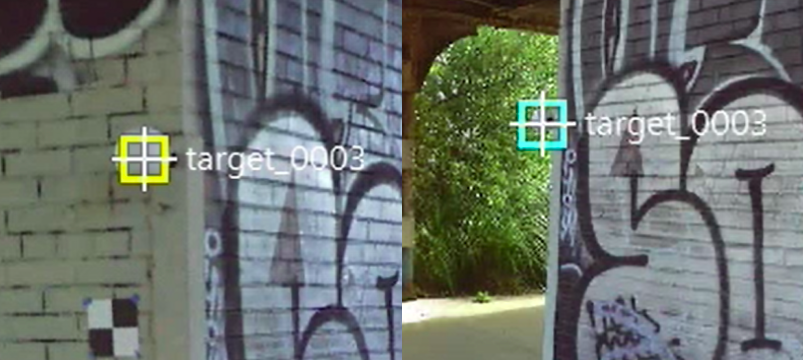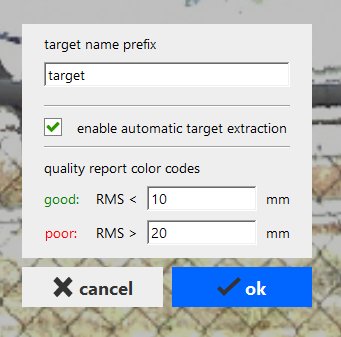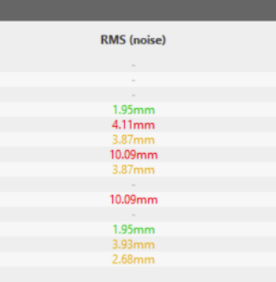Automatic Target Extraction
Automatic target extraction (ATE) allows for the automatic identification and addition of targets. After a target is added, the matching targets in the neighboring scans are automatically extracted.
To use Automatic Target Extraction
Manually select a target and name a target in the add-target dialog box. The same targets in other scans will now be extracted and marked as automatic targets. If there are matching targets detected, progress on the matching scans will be shown in the following view to indicate one target is matched between those scans.
The manual target will be shown in yellow, and the automatic targets will be shown in cyan.

If the new name already exists, you will need to associate this target with the existing target.
If you made an error in selecting the manually selected target, the selected target and all of the associated automatically selected targets must be deleted. When one manual target is deleted, all the related automatic targets will be deleted automatically.
If the manually picked target is correct, you can now inspect the other automatic targets. You can quickly check the RMS value for the newly added automatic targets in the quality report instead of switching to each scan and check. If an automatic target is incorrect, you will need to delete the automatic target. By clicking on the target name in the connection tab, you can navigate to that target to visually check the quality of that target extraction. Other automatic targets are not impacted. You can manually select the target to get a more accurate result.
If there are still some target observations missing after the automatic target extraction, you can manually pick the targets instead and associate this target observation with the existing target.
If there is a tick in the manual column of the quality report, it indicates that that the target is manually extracted, otherwise, the target is automatically extracted.
Registration Setting
Use the registration setting dialog to set the options related to automatic target extraction. Click the setting button in the lower bottom toolbar to open the registration setting dialog.

Target name prefix: The default target name prefix is ‘target’. You can set the target prefix for the default target name. 001, 002 … will be automatically attached to the target prefix to create the suggested target name when a target is manually extracted. An empty target prefix is allowed.

Enable automatic target extraction: Automatic target extraction is enabled by default. You can uncheck the option to disable the automatic target extraction.
Quality report color codes: The quality report color codes are used to colorize the RMS value shown in the quality report dialogs. By default, the criteria for ‘good’ quality is when the RMS value is less than 10mm. The criteria for ‘poor’ quality is when the RMS value is more than 20mm. You can modify the criteria of good and poor quality to colorize the RMS value. The maximum allowed RMS value setting is 100mm.

Miscellaneous
Automatic target extraction only works in the left registration view or when the project is fully registered. Although in the right registration view, no automatic targets will be extracted after a manual target is added, deletion and modification to a manual target will still be reflected in the related automatic targets as well.
Projects suspended with automatic targets can be opened in an older version of ReCap Pro, but automatic targets will be displayed as manual targets.
